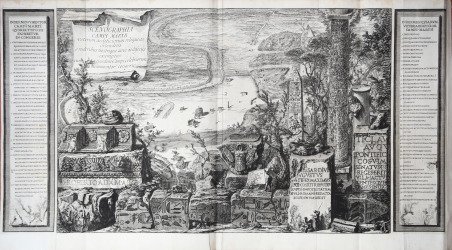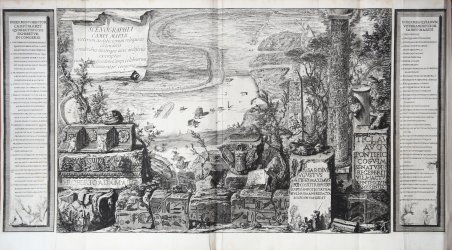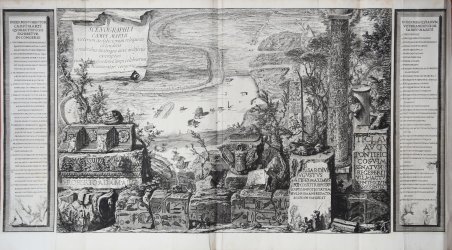Acquaforte, bulino e puntasecca, circa 1762, firmata in lastra in basso a sinistra. Magnifica prova, impressa su carta vergata coeva con filigrana “doppio cerchio e giglio con lettere CB” (Robison 35), con margini, consuete tracce di pieghe verticali, in eccellente stato di conservazione. Tavola tratta da ' Il Campo Marzio dell’Antica Roma opera di G.B. Piranesi socio della Real Società degli Antiquari di Londra. Una delle tavole più importanti dell’opera, sicuramente la più affascinante. La scenografia del Campo Marzio apre ad uno spazio meraviglioso, creando una prospettiva aerea della zona alle spalle di un fascinoso assembramento di ricostruzioni di rovine e reperti. Fra questi giganteggia il fusto spezzato dell’obelisco di Psammetico II, che l’imperatore Augusto aveva eretto nel cuore del Campo Marzio, utilizzandolo come meridiana, e che papa Benedetto XIV fece disseppellire nel 1748. Sebbene pubblicata solo nel 1762 questa fondamentale opera, che appare come una delle più complesse del Piranesi, veniva già annunciata dall’artista nelle Antichità Romane (1756) ' delle quali, secondo Focillon, può essere considerata come il quinto tomo. La vicenda del Campo Marzio si intrecciano con l’amicizia con lo scozzese Robert Adam, al quale l’opera è dedicata. Adam era giunto a Roma nel 1755 e ben presto aveva conosciuto Piranesi, forse per mezzo del comune amico Charles-Louis Clerisseau, trovando nella comune passione archeologica la base di una reciproca stima, che continuò anche dopo il ritorno dell’architetto Londra. Fu proprio Adam che, durante le ricognizioni dei resti dei monumenti del Campo Marzio, suggerì al Piranesi l’idea di realizzare una mappa dell’intera area, che inizialmente doveva essere inclusa nelle Antichità, e poi finì per costituire la base di un progetto ben più ambizioso, dando alla luce questa importante opera. Negli scritti iniziali l’autore annuncia lo scopo di questo lavoro, affermando la volontà di voler tracciare la storia di questa vasta area compresa tra il Tevere ed i colli, cercando di ricostruirne la conformazione ed il volto. Egli sottolinea la difficoltà di tale lavoro di ricostruzione, poiché l’antico Campo Marzio ha coinciso con l’area più intensamente popolata e riedificata della città dal medioevo all’epoca attuale, non nascondendo il margine di ipotetica insito nell’opera. Il risultato è che l’attendibilità dei risultati rimane quanto mai problematica, sia per la pionieristica ricerca archeologica del tempo, sia per la carica visionaria che porta l’artista e l’architetto a superare di slancio i limiti della realtà storica progettando il passato in funzione del presente, portando il genio artistico a prevalere di gran lunga sull’archeologo, conferendo senso e vigore a tutta l’opera. Bibliografia Focillon 437, Wilton Ely 568. ' Etching, engraving and drypoint, circa 1762, signed in plate at lower left. Magnificent proof, printed on contemporary laid paper with watermark "double circle and lily with letters CB" (Robison 35), with margins, usual traces of vertical folds, in excellent condition. Plate taken from ' Il Campo Marzio dell’Antica Roma opera di G.B. Piranesi socio della Real Società degli Antiquari di Londra. One of the most important plates of the work, certainly the most fascinating. The setting of the Campus Martius opens to a wonderful space, creating an aerial perspective of the area behind a fascinating assemblage of reconstructions of ruins and artifacts. Among these is the broken shaft of the obelisk of Psammeticus II, which the Emperor Augustus had erected in the heart of the Campus Martius, using it as a sundial, and which Pope Benedict XIV had dug up in 1748. Although published only in 1762, this fundamental work, which appears to be one of Piranesi's most complex, had already been announced by the artist in the Antichità Romane (1756) of which, according to Focillon, it can be considered as the fifth volume. The story of the Campus Martius is intertwined with the friendship with the Scotsman Robert Adam, to whom the work is dedicated. Adam had arrived in Rome in 1755 and soon got to know Piranesi, perhaps through their mutual friend Charles-Louis Clerisseau, finding in their common archaeological passion the basis of a mutual esteem, which continued even after the architect's return to London. It was Adam himself who, during the reconnaissance of the remains of the monuments of the Campus Martius, suggested to Piranesi the idea of creating a map of the entire area, which initially was to be included in the Antiquities, and then ended up forming the basis of a much more ambitious project, giving birth to this important work. In the initial writings the author announces the purpose of this work, stating the will to trace the history of this vast area between the Tiber and the hills, trying to reconstruct the conformation and the face. He underlines the difficulty of this reconstruction work, since the ancient Campus Martius coincided with the most intensely populated and rebuilt area of the city from the Middle Ages to the present time, not hiding the margin of hypothetic inherent in the work. The result is that the reliability of the results remains very problematic, both for the pioneering archaeological research of the time, and for the visionary charge that leads the artist and the architect to overcome the limits of historical reality designing the past in function of the present, bringing the artistic genius to prevail by far on the archaeologist, giving sense and vigor to the whole work. Literature Focillon 437, Wilton Ely 568. ' Cfr.



Découvrez comment utiliser
Découvrez comment utiliser

